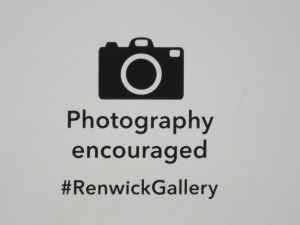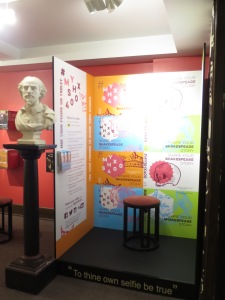The Folger Library in Washington, DC is one of my favorite places because it’s about books and Elizabethan England, two things that fascinate me. As an historian, books are not an unusual passion but as an American historian, I’m interested in the Elizabethan period because of the comparisons to our Colonial era. So every time the Folger mounts an exhibit in their gallery, I go no matter the topic and want to document what I’ve seen and learned through photos (and share them with you!). And yet, while copyright protects none of the material on exhibit, the guards frequently stop me from taking photos and one time I even had to prove I deleted the images from my camera. The latest exhibit on Shakespeare was photo-prohibited because it was on loan, but again, none of the materials were protected by copyright (all pre-dated 1700). Ironically, at the entrance to the exhibit is a special booth where visitors were asked to share videos or photos of themselves talking about Shakespeare on Twitter, Instagram, and Facebook. Huh? To thine own selfie be true, as long as it doesn’t include any actual historic objects on exhibit.
 That’s such a contrast to other museums in DC which encourage photography. The “Wonder” exhibit at the Renwick Gallery of Art in Washington, DC, is filled with contemporary art, which is typically tied up in a particularly rabid form of copyright protection, encourages photography with signs mounted in nearly every gallery. Somehow they’ve figured out how to allow photography by the public without jeopardizing their collections, reputation, or loan agreements.
That’s such a contrast to other museums in DC which encourage photography. The “Wonder” exhibit at the Renwick Gallery of Art in Washington, DC, is filled with contemporary art, which is typically tied up in a particularly rabid form of copyright protection, encourages photography with signs mounted in nearly every gallery. Somehow they’ve figured out how to allow photography by the public without jeopardizing their collections, reputation, or loan agreements.
Museums and libraries have to figure out how to embrace photography.* While overall attendance has dropped for the past thirty years, interest in photography has grown by leaps in bounds.** Indeed, it’s the only cultural or artistic activity that’s growing in the US and by prohibiting it unconditionally, museums and libraries are only further distancing themselves from the rest of America.
*The Rauschenberg Foundation recently developed a radical but thoughtful photography policy, which is described in the New York Times.
**National Endowment for the Arts, “Survey of Public Participation in the Arts,” 2012.


I wont name names but its a place we both know well – and they still have a bug up. Meanwhile I recently posted my most emphatic argument yet on Housing Our History – about how photography is building a whole new audience – the most zealous and enthusiastic HH goers I know are doing instragram and sharing on FB. This #HistoricHouseCrush thing out of Salem is cool. I would love to crowd source an exhibition of what folks see in HH’s. Now this popped up. It is astonishing – embarrassing – that museums with large professional staff are stuck on this (some are – some aren’t) – a little more understandable if its an HH with a board whose average age is 74. But this is a movement and its all to the good. My ability to do what I do – would not exist if I hadn’t been relentless about photographing inside museums – 8000 pix and growing! https://philanthropy.com/article/Instagram-Fame-Sends/235549/?key=a_mP6FEbJ3bmIi3hOaFi5PNq-IYDtQcOWtB49SjUkSF4U3AtQXEtNWEyN2xTV0I5Q1F5azB1NlJGLXZHQmRlSG43emVIVU9VV0Uw
LikeLike
It’s something we’re working on too – but I think overall we’re pretty photo-friendly. For example, we now include hashtags for our major programs in the visitor guides and signage for that program, and in some places in our exhibits as well.
LikeLike
The historic materials are not copyrighted but the design of the exhibits themselves are. Is it due to the exhibit designer claiming the rights or lack of communication with staff that photography is now okay. Or are they couching it as ‘protecting’ the historic materials?
LikeLike